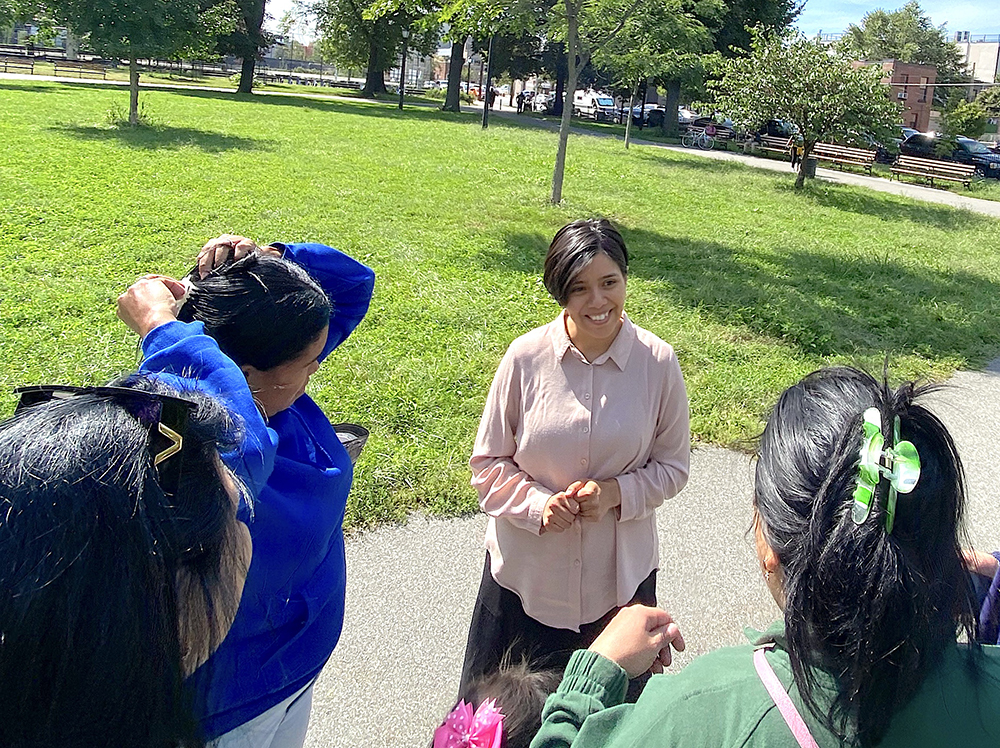
RED HOOK — Aloni Bonilla is learning to be an accomplished fundraiser, but she has no ambition to be a development director earning a six-figure income.
Instead, she aspires to serve the Lord and His people as a consecrated sister in a religious community. But before she can do that she has to overcome a formidable obstacle: an unpaid student loan.
Taking a vow of poverty means having insufficient income to pay debts. Therefore, most religious orders can’t afford to accept formation candidates with debt.
Bonilla, a Los Angeles native, is the office assistant and coordinator of religious education at Visitation of the Blessed Virgin Mary in Red Hook. She has a master’s degree in divinity from the Franciscan School of Theology at the University of San Diego — hence, her debt.
“Shortly after reading the Gospel of Matthew, I had an experience with the risen Lord Jesus,” Bonilla explained. “From that moment on, I knew Jesus was calling me to be his disciple, just as he called Matthew. I just have to overcome the student loan obstacles.”
Bonilla is not alone in this challenge. Of a sampling of 10,000 people discerning a religious vocation or the priesthood, an estimated 42% of them can’t begin formation because of student loan debt, according to data from the Labouré Society, a nonprofit based in Eagan, Minnesota, that helps vocation candidates raise money to pay off their loans.
The organization gets its data from research conducted by the National Religious Vocation Conference, the Center for Applied Research in the Apostolate (CARA), and the U.S. Conference of Catholic Bishops. Much of the data is based on studies, some conducted jointly by these groups, in 2009, 2012, and 2013.
The issue isn’t going away, said Sister Maryann Seton Lopiccolo, the episcopal delegate for religious in the Diocese of Brooklyn.
One of her responsibilities is welcoming and helping women and men in religious formation ministry. From her perspective, student debt among candidates is “a new phenomenon” that emerged about 20 years ago.
Sister Maryann attributed the trend to the soaring costs of higher education.
She noted that earlier generations of candidates entered seminary or religious life soon after high school. They may have gone to college for one or two years, she added.
Nowadays, according to Labouré, every third person who considers religious life has an average student loan debt of $28,000, while the average debt of those who come to Labouré for help is $60,000. In addition, the society reports, in the past decade, 7 of 10 communities declined to accept candidates because of their loans.
Sister Maryann also noted that most religious communities prefer to accept candidates before they’re 35 years old, which makes for a tight window for as-piring sisters to repay their college loans. Meanwhile, the population of religious sisters in the U.S. has declined steadily since the height of 181,421 in 1966. The latest CARA data shows the U.S. had 36,321 religious sisters as of 2022.
Sister Maryann applauded the work of Labouré as well as two other organiza-tions: the Fund for Vocations in Esmont, Virginia, a provider of student-debt re-lief grants, and the National Religious Vocation Conference in Chicago, which assists through its National Fund for Catholic Religious Vocations.
“If candidates feel called to religious life, and finances are the deterrent, I would suggest that they look into any of those corporations to see what kind of assistance they can get,” Sister Maryann said. Bonilla said Labouré is helping her “rescue” her vocation. Since 2004, the organization has helped more than 400 “aspirants” enter formation for the priesthood or religious life, but the future clergy and nuns do the heavy lifting.
The Labouré method involves placing aspirants on a fundraising team called a “class.” For example, Bonilla’s class includes 16 men and women from all over the U.S.
They’re taught fundraising techniques like goal setting, making cold calls, letter writing, and face-to-face presentations.
Together, they seek donations to be shared among them for repaying their student-loan debts. Each class member aims to raise $60,000 — the average amount owed by aspirants — by Dec. 31, according to information from Labouré.
Bonilla’s goal is to enter consecrated life with the worldwide Koinonia John the Baptist community which she first encountered in California. Priests, sisters, brothers, and laity from the community form the staff at Visitation of the Blessed Virgin Mary.
Although the fundraising goal may seem daunting, Bonilla is inspired by the community, parishioners, the support of her Labouré teachers and classmates, and the debt itself.
“This wonderful debt — I call it wonderful because it really is a burden-to-a-blessing,” Bonilla said. She explained that because of the debt, she has learned to “fully have faith in the providence of the Lord.
“The Lord is saying, ‘No, I want you to trust me completely,’ ” she said. “And before I enter, I need to learn this lesson.”
For more on the Labouré Society, visit rescuevocations.org.
